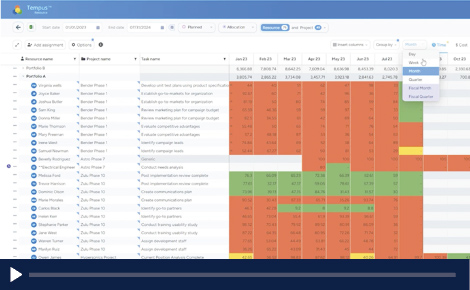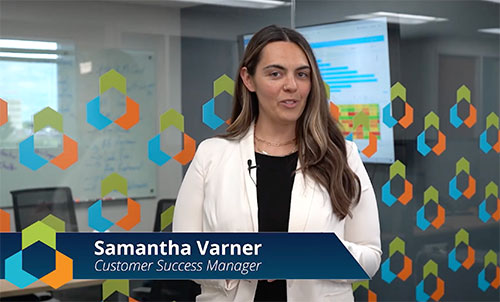Business leaders and Resource Managers must continuously align their organization’s strategy, planning and execution with constantly changing availability and workload of employees, business goals, and other outside factors. Part of this alignment involves deciding how much to focus on the lofty goals and visionary ideas that can revolutionize a business, versus the daily needs to run a business. Those decisions about priorities also must consider employees’ workload and future availability, how much room is in the budget to achieve these goals, and deadlines.
In this guide, we’re going to talk about resource management – what it means, why you need resource management, how resource management fits with project management and implementing strategy for your business, and a how to use a resource management maturity model so you can best understand where your organization currently stands and how you can take steps to adapt and grow.

What is Resource Management?
Our ability to finish projects and accomplish our goals is fundamentally determined by having qualified people. Without people, we can’t do work, execute projects, or implement strategy. Resource management helps us most effectively utilize our people to achieve our business goals. Resource management helps match our supply of people (resource capacity) with our demand for people (resource allocation).
Task-oriented planning is great, but without understanding the near-, mid- and long-term impact on key skills, roles and individuals, even the best plans are destined to fail. Resource management is the foundation of project delivery and strategy execution. Whether your goal is to innovate, drive transformation, or improve profitability in record time, your teams must become efficient practitioners of resource management to experience portfolio success. To do so, you need a specialized solution designed with Resource Managers in mind.
Check out our video, What is Resource Management?
Why Do You Need Resource Management?
Without effective resource management, most organizations find themselves struggling to optimize or even maintain a strong project portfolio or achieve their strategic goals. Issues arising from budget constraints, deadlines and employee availability can get in the way of getting the job done.
For too long, organizations have failed to effectively manage the connection of resources and strategy – impacting their ability to create a sustainable competitive advantage. While this often manifests as a failure to deliver on a particular project, the unfortunate truth is that the longer-term effects negatively impact an organization’s ability to innovate, transform, and be profitable.
Check out our video, Why Do You Need Resource Management?

Is Resource Management the Same as Strategic Portfolio Management or Project Portfolio Management?
Resource management differs, but aligns with Strategic Portfolio Management, which is the process of creating a strategy for the entire business and building the supporting projects, products, roadmaps and plans to execute that strategy. Strategic Portfolio Management is designed to produce an executable plan. It’s not just about the strategy and important decisions, but also whether and how the work gets done. It’s the portfolio of work that will help your business achieve that strategy’s goals. Resource management helps business strategy reach the finish line. While Strategic Portfolio Management sets up the focus and strategy well, RM helps execute the strategy with the right people, with the necessary skills, using the correct plan via effective business processes.
While many consider resource management and Project Portfolio Management (PPM) similar, what sets them apart is critically important for successful project management. Most PPM tools focus largely on the tasks required to execute a project. While PPM may consider multiple projects, it is still structured to evaluate projects based on their individual requirements as opposed to how those requirements could create conflict across other projects in your portfolio. Resource management takes a holistic view of the entire project portfolio by broadening the planning horizon beyond task-based assignments and focusing instead on how resources are being allocated and utilized throughout the organization, incorporating workload into the planning process. Project managers need to bridge resource management together with capacity planning. Capacity planning looks at the big picture of whether an organization has the person capacity and skill sets required to fulfill the future demand of programs and projects. This is typically a strategic planning process that looks months or years ahead, taking time, skills, and demand into consideration.
The best solution for resource management and capacity planning need to have:
- Resource capacity planning tools
- Project forecasting
- What If analysis
- Time tracking
- Customizable reporting
- Skills management
What Comes First: Resource Management or Project Management?
Projects are driven by your portfolio, which is really driven by a company’s vision and goals. Resource Managers need to balance the needs of your employees with those strategic goals.
Check out our video, What Comes First: Resource Management or Project Management?
How to Implement a Resource Management Strategy
It’s important to note that any resource management strategy requires having a strong resource management solution already in place. Too often, Resource Managers rely on tools – typically project management software – that force them into a strait jacket of project planning. These tools shift your focus to tasks and task relationships – the sequencing of steps and Work Breakdown structures – not on the most critical, expensive, and limited quantity asset essential to the success of your project and strategy: resources. Without a focus on resources, these software solutions overcomplicate the process and often fall apart when they clash with the real-world requirements of resource management. In other cases, resource planning is managed in a tangled web of spreadsheets. We are all too familiar with management by spreadsheet and its pitfalls. Not only is the process virtually guaranteed to end in frustration and even more spreadsheets, but the results are also the same – zero insight into the alignment of resources, strategy and business.

With the right platform in place, your organization can begin the comprehensive planning process to better utilize resource capabilities. To learn more about why using spreadsheets is risky for resource management, watch our webinar.

Why Do Projects Fail? Read about some of the most common mistakes and how to avoid them.
Resource Management Maturity Model
If resource management helps us effectively utilize our people to achieve our business goals, then there are natural stages to how this is achieved. For some organizations, it starts with simply looking ahead to how employees can be better assigned to projects that maximize their job skills and don’t overwork them. For more advanced teams, that can involve more proactive analysis of roles, responsibilities and projects 18 months to two years out for better resource forecasting and capacity planning. By following a resource management Maturity Model, you can assess where your organization falls in its use of true resource management, not just Project Management. You can also follow some clear steps to move your efforts forward and evolve into a more mature organization.
Level 1: Reactive Ad Hoc Task Assignments
In Level 1, a person’s assignment to a project is reactive only, often after the project has been approved. It is likely that the Project Manager is assigning tasks to people who only seem to be available, or worse, the person they prefer to have on the project. There is no communication with the Resource Manager about who is best for the task and when they are available to fully commit to the work.
Project Managers are assigning tasks that align with their own projects’ timelines without considering project priority or resource availability. Often, tools like Asana, JIRA, Monday.com or Smartsheet (and many of them) are in place to assign resources to the task and the task completion date.
Common Issues:
- Excel spreadsheets or many task management tools in place to “assign” tasks
- No centralization of resources, their roles or skills and capacity
- No visibility beyond the completion of the tasks
- Assignments are uneven throughout the team, leading to too much work for some and not enough for others
- No reporting or analytics to show project risks or successes
Level 2: Reactive Resource Assignment by Resource Managers
In Level 2, Resource Managers now have a greater say into the assignment of their team members but, without understanding project priority and actual capacity. There may be a formal meeting set up for Product Managers and Resource Managers to discuss who will be working on the project before the person is assigned to it. Project Managers may still request specific resources to work on the project.
Often, this hour or FTE (full time equivalent) estimation is captured in an Excel spreadsheet by the Resource or Project Manager.
Common Issues:
- Excel sheets are hard to maintain and not multi-user friendly
- Each team has their own project or task management tools in place with no opportunity to see all work going on across the organization
- If Project Managers and Resource Managers are not meeting regularly, resource allocation risks go undetected and unsolved
- Employees’ skills, experience and knowledge is not leveraged in assignments
Level 3: Centralized Resource Management Processes
In Level 3, the business has determined that Excel spreadsheets and task management tools no longer fit their need for structured resource management. The PMO (Project Management Office) or Resource Planning team has decided to adopt a solution that includes a resource pool of all people in the organization, their capacity, skills and experience.
Resource Managers are now able to view their team’s capacity and skills compared to the projects’ demands. Resource Managers can proactively call out when a resource is over-allocated and find a solution before the project is at risk. Project Managers can track time spent on the project to avoid being over budget. The business can begin planning three to 12 months into the future if projects are planned that far in advance.
- Project management is done outside of the resource management tool
- Project managers can assign the role needed for the project for the estimated time or FTE needed
- Resource managers review resource availability and skills to ensure balanced and fulfilling assignments for all team members
- Organizational leadership can start to see the gaps between project demands and resource capacity
Level 4: Proactive Capacity Planning and Resource Forecasting
In Level 4, Portfolio, Project and Resource Managers align their projects and people to the top priority work within the company. Project consideration and approval now includes an analysis of the roles and people needed to complete the work.
Because resource availability is included in the project demand management process, teams can practice capacity planning and resource forecasting. Not only does the team know the current resource plan but, they can speak to six, 12 or 18+ months in the future.
Common Processes:
- Integration between project, HR and resource management systems
- Projects are now aligned with the strategic portfolio objectives of the organization
- Resource plans are considered when approving projects; resource utilization is a key metric in planning
- What-If models are used to determine project start and end dates based on resource availability
- Reports and dashboards are leveraged for all manager and leaders to review project health, resource risks related to project demands and labor costs, and resource utilization
Level 5: A Formal Resource Management Office is a Strategic Function
In Level 5, A resource management office (RMO) manages all resources, their project assignments, their current skills and future aspirations. The Resource Manager role can be considered the team’s functional manager or, that person can work alongside the functional manager. The Resource Manager’s goal is to align the employees’ current ability with their career aspirations and portfolio needs. They look beyond just resource utilization rates and ensure that the resource is fulfilled, and the project is properly staffed to the demand.
- Regular check-ins with resources to determine their career aspirations
- The RMO has a seat at the leadership table
- Success of the project and portfolio is tied directly to the resource plan

Additional Resources

For those looking for tips to help you implement your organization’s resource management strategy and excel as a Resource Manager, read our Guide to Developing Skills as a Resource Manager.

To learn more about how to balance resources and strategy within your organization, read our Guide to Strategic Portfolio Management and Resource Management.

Visit our YouTube channel for helpful tutorials about many resource management topics including creating a resource utilization rate, how to transition from spreadsheets to a resource management platform, and how best to harness modeling and scenario planning.
To learn more about why a resource management platform is essential for your organization and what pitfalls your business may experience without one, read our Buyer’s Guide to Resource Management.




